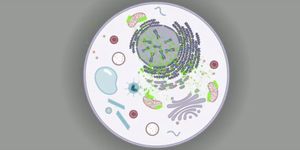How Genetic Gatekeepers Guide the Development of Organisms
Many of the same genes can be found in different organisms, from yeast to humans, which has allowed researchers to study the role of human genes in model organisms, or follow the evolution of different species from a common ancestor, for example. Hox genes (a subset of homeobox genes) are known to sit in the genome of every animal, and cells use them to regulate genes during development; these genes help direct where limbs will end up. Scientists have tried to understand how these genes orchestrate the body map of organisms.
An international team of researchers has now developed a technique for elucidating what Hox genes do in a common model organism, the fruit fly. Their work has been reported in Nature Communications, and can help us make sense not only of the growth process, but also aging and potentially give us insight into disease.
"The genome, which contains thousands of genes and millions of letters of DNA, is the most complicated code ever written," said study co-senior author Richard Mann, Ph.D., a principal investigator at Columbia's Mortimer B. Zuckerman Mind Brain Behavior Institute. "Deciphering this code has proven so difficult because evolution wrote it in fits and starts over hundreds of millions of years. Today's study offers a key to cracking that code, bringing us closer than ever to understanding how Hox genes build a healthy body, or how this process gets disrupted in disease."
Even primitive jellyfish, some of the oldest organisms on earth, carry Hox genes. Various combinations are carried by different animals - humans have 39 and fruit flies have eight. The genes code for transcription factors, which help regulate the expression of other genes. This gives them immense control over the action, but with so many of them at work, it's been tough to reveal the role of each one.
"Because these genes are intricately involved in many aspects of development, it has proven incredibly challenging to isolate individual Hox genes and trace their activity over time," explained study co-senior author James Castelli-Gair Hombría, Ph.D., a principal investigator at the Centro Andaluz de Biología del Desarrollo at the Universidad Pablo de Olavide. "We had this incredibly complex equation to solve but too many unknowns to make significant progress."
Hombría's team happened to come across a bit of regulatory DNA in the developing fly. This unusual piece, called vvI1+2, was active in cells all over the developing fly, and was also being controlled by each of the eight Hox fly genes.
The video describes how regulatory networks control development.
"The ubiquity of the vvI1+2 DNA segment across the entire developing fruit fly, combined with the fact that every Hox gene touches it, made it an ideal system by which to study the Hox gene family," noted the study first author Carlos Sánchez-Higueras, Ph.D., a postdoctoral researcher in the Hombría lab. "In this single piece of DNA, we had the perfect tool; we could now devise a method to systematically manipulate vvI1+2 activity to see how each Hox gene functioned."
The researchers worked with Mann at Columbia to create an algorithm he and others recently created, which can find the places on DNA where transcription factors bind. It even reveals weak binding sites. They zeroed in on the places where Hox and cofactors link up with vvI1+2.
"Our analyses provided a precise road map of Hox binding sites in vvI1+2, which we could then apply to a living fruit fly," said Mann.
This work enabled them to manipulate Hox activity. "We now had a starting point from which to systematically decode Hox gene regulation; a kind of Rosetta Stone to help us decipher the genetics of body development," said Hombría. It can also be applied to the whole genome of fruit flies, and other organisms.
"While there is much about Hox genes that remains to be elucidated, our work is a significant step forward," said Sánchez-Higueras. "These continued efforts, combined with those of our peers, will help shed light on how the whole system works together in a growing embryo and how they contribute to disease."
Sources: AAAS/Eurekalert! via The Zuckerman Institute at Columbia University, Nature Communications








